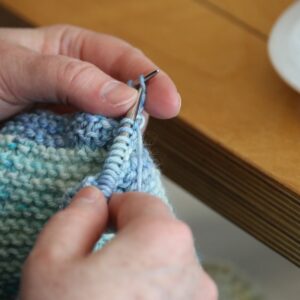Handwriting. Do we still even know how to do it? We spend most of our day with our fingers on the computer keys (as I’m doing right now) or our thumbs on our smartphones. When do we write by hand?
For me, it’s when I write checks, or grocery lists (increasingly illegible), or notes to my husband to leave on the kitchen table (“I’m out for a walk” or “Pls bring up the laundry”). Also the occasional condolence card. That’s about it.
I remember the pre-computer days when I’d write essays and even whole books by hand. I wouldn’t type them on my Smith-Corona typewriter until the final draft. I postponed the typing step for several reasons. Corrections were fussy to make on the typewriter. Plus, writing by hand, I’d draft each paragraph on a separate sheet of paper. That way I could lay the sheets overlapped on the floor, with just the topic sentence of each paragraph showing: a convenient way to see how my argument was developing.
The final virtue of writing by hand was the most important. As each word passed from my brain through my hand to the letters formed on the paper, the word had time to be reflected on…and sometimes to be changed.
Denise Levertov elaborated on this virtue of handwriting in some thoughts about writing poetry, quoted by Garrison Keillor on her birthday in 2011:
If you copy something out by hand, before you move onto the typewriter, you’ve already gone on making minor changes. This is an intuitive part of the creative process, and one that’s eliminated by the use of word processors. People get such a completed-looking copy that they think the poem is done. The word processor doesn’t take as much time as actually forming the letters with your hand at the end of your arm which is attached to your body. It’s a different kind of thing. They don’t realize that this laborious process is part of the creative process.
I haven’t written poetry. But in my pre-computer days, when I wanted to copy out a favorite poem to memorize it, just moving it through my brain to my hand already made it part of me. Keyboarding favorite poems, which is my current practice, just doesn’t do this. Then of course there’s the ultimate laziness of copy/pasting a poem from a website. Doing this keeps the poem from passing through my brain at all. It becomes no more a part of me than the recipes I copy/paste from the web.
Decades ago, when I started to think of myself as a writer, I began keeping a journal. It was a sort of “commonplace book,” modeled on Virginia Woolf’s. I’d write out passages I’d read, usually of prose, that I wanted to keep. I’d sometimes muse on them—or play with developing their metaphors. Of course this was all by hand.
I don’t keep a journal any more. Does anyone? I think by nature a journal has to be handwritten; I can’t imagine it would be a journal if keyboarded. I wonder why not? I think it’s, again, that intimacy of hand to brain—the very physicality of the process. And when I say “handwritten,” I’m thinking “cursive.” That connectedness of letters that keeps up the flow of thoughts.
But you’d be amazed by what a controversy there is over cursive. Especially over whether to teach it in schools. Teaching cursive used to be standard in, usually, second grade (That’s when I learned it.) But then in 2010, the Common Core standards adopted by nearly every state in the U.S. dropped the requirement to teach cursive.
Not long thereafter, war broke out: pro-cursive forces versus con. So crucial was the conflict that it drew national news media attention.
Here’s USA Today, in a 2013 article titled “Is cursive’s day in classroom done?” The answer was: probably. Standardized tests were being given on computers, so cursive seemed to have lost a primary purpose. At that time, forty-one states had stopped requiring schools to teach cursive writing…or even cursive reading. But some teachers were protesting. One said: “I think it’s a basic element of students’ control and peace of mind. You pay attention to what you’re doing when you’re writing in that format.”
A 2013 piece in Psychology Today added scientific ammunition to the pro-cursive side. Titled “Biological and Psychology Benefits of Learning Cursive” and subtitled with the command “Don’t let your schools stop teaching cursive,” the article cites a researcher in educational psychology who had found that “Handwriting dynamically engages widespread areas of both cerebral hemispheres” and that “brain scans during handwriting show activation of massive regions of the brain involved in thinking, language, and working memory.”
The following year, The New York Times joined forces with the fight for cursive, announcing its allegiance right in the title of its June 2014 article: “What’s Lost as Handwriting Fades.” The answer was “a lot”—in fact, the very process of learning. “New evidence” from psychologists and neuroscientists “suggests that the links between handwriting and broader educational development run deep.” The Times then quotes a French psychologist (so the cursive controversy had gone international?): “When we write, a unique neural circuit is automatically activated…. There is a core recognition of the gesture in the written word, a sort of recognition by mental simulation in your brain. And it seems that this circuit is contributing in unique ways we didn’t realize.” The upshot? “Learning is made easier.”
The same month as the Times article, Time magazine reported on Tennessee state Representative Sheila Butt’s battle to mandate the teaching of cursive in all public schools. Her arguments: (1)We need to be able to read cursive. (2)Many documents still require signatures. (3)It’s good for our minds. (This last point then marshalled the scientific evidence I’ve already noted). Rep. Butt convinced her colleagues; the Tennessee legislature made it a law that cursive be in the school curriculum.
When I started writing (umm, well, keyboarding) this post, I had no idea it would take me into this Monumental Cursive Conflict. I hadn’t known about cursive engaging various areas of the brain. Or that, as Reader’s Digest reported in a comprehensive April 2020 article on the controversy—”Should Schools Bring Back Cursive Handwriting?”—learning handwriting can enhance reading fluency.
But all this makes sense to me.
So count me in on the side of those fighting to return cursive to the curriculum. And it looks as if we’re starting to win. According to an April 2019 CNN report, teaching cursive is now required in eighteen mostly southern states, including Texas. (Hmm, so is cursive conservative?)
I’m not playing Luddite here. Computers and word processing are invaluable. But so is handwriting—and for more than signing checks.
I should start my journal-writing again.
Peggy Rosenthal has a PhD in English Literature. Her first published book was Words and Values, a close reading of popular language. Since then she has published widely on the spirituality of poetry, in periodicals such as America, The Christian Century, and Image, and in books that can be found here.





